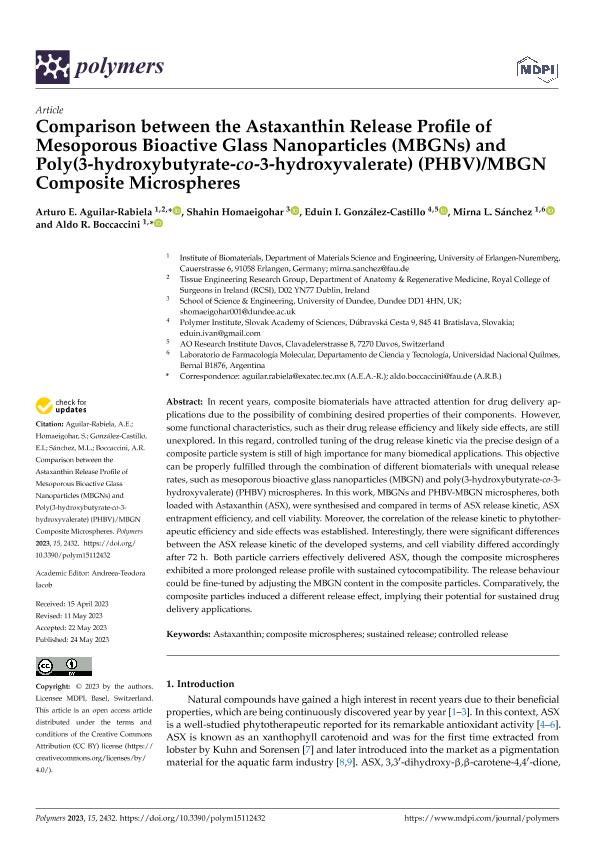Mostrar el registro sencillo del ítem
dc.contributor.author
Aguilar Rabiela, Arturo E.
dc.contributor.author
Homaeigohar, Shahin
dc.contributor.author
González Castillo, Eduin I.
dc.contributor.author
Sanchez, Mirna Lorena

dc.contributor.author
Boccaccini, Aldo R.
dc.date.available
2023-12-12T12:05:27Z
dc.date.issued
2023-06
dc.identifier.citation
Aguilar Rabiela, Arturo E.; Homaeigohar, Shahin; González Castillo, Eduin I.; Sanchez, Mirna Lorena; Boccaccini, Aldo R.; Comparison between the Astaxanthin Release Profile of Mesoporous Bioactive Glass Nanoparticles (MBGNs) and Poly(3-hydroxybutyrate-co-3-hydroxyvalerate) (PHBV)/MBGN Composite Microspheres; MDPI; Polymers; 15; 11; 6-2023; 1-13
dc.identifier.issn
2073-4360
dc.identifier.uri
http://hdl.handle.net/11336/219917
dc.description.abstract
In recent years, composite biomaterials have attracted attention for drug delivery applications due to the possibility of combining desired properties of their components. However, some functional characteristics, such as their drug release efficiency and likely side effects, are still unexplored. In this regard, controlled tuning of the drug release kinetic via the precise design of a composite particle system is still of high importance for many biomedical applications. This objective can be properly fulfilled through the combination of different biomaterials with unequal release rates, such as mesoporous bioactive glass nanoparticles (MBGN) and poly(3-hydroxybutyrate-co-3-hydroxyvalerate) (PHBV) microspheres. In this work, MBGNs and PHBV-MBGN microspheres, both loaded with Astaxanthin (ASX), were synthesised and compared in terms of ASX release kinetic, ASX entrapment efficiency, and cell viability. Moreover, the correlation of the release kinetic to phytotherapeutic efficiency and side effects was established. Interestingly, there were significant differences between the ASX release kinetic of the developed systems, and cell viability differed accordingly after 72 h. Both particle carriers effectively delivered ASX, though the composite microspheres exhibited a more prolonged release profile with sustained cytocompatibility. The release behaviour could be fine-tuned by adjusting the MBGN content in the composite particles. Comparatively, the composite particles induced a different release effect, implying their potential for sustained drug delivery applications.
dc.format
application/pdf
dc.language.iso
eng
dc.publisher
MDPI
dc.rights
info:eu-repo/semantics/openAccess
dc.rights.uri
https://creativecommons.org/licenses/by/2.5/ar/
dc.subject
ASTAXANTHIN
dc.subject
COMPOSITE MICROSPHERES
dc.subject
CONTROLLED RELEASE
dc.subject
SUSTAINED RELEASE
dc.subject.classification
Otras Ingeniería de los Materiales

dc.subject.classification
Ingeniería de los Materiales

dc.subject.classification
INGENIERÍAS Y TECNOLOGÍAS

dc.title
Comparison between the Astaxanthin Release Profile of Mesoporous Bioactive Glass Nanoparticles (MBGNs) and Poly(3-hydroxybutyrate-co-3-hydroxyvalerate) (PHBV)/MBGN Composite Microspheres
dc.type
info:eu-repo/semantics/article
dc.type
info:ar-repo/semantics/artículo
dc.type
info:eu-repo/semantics/publishedVersion
dc.date.updated
2023-12-11T18:03:05Z
dc.journal.volume
15
dc.journal.number
11
dc.journal.pagination
1-13
dc.journal.pais
Reino Unido

dc.description.fil
Fil: Aguilar Rabiela, Arturo E.. Universitat Erlangen-Nuremberg; Alemania
dc.description.fil
Fil: Homaeigohar, Shahin. University Of Dundee; Reino Unido
dc.description.fil
Fil: González Castillo, Eduin I.. No especifíca;
dc.description.fil
Fil: Sanchez, Mirna Lorena. Universitat Erlangen-Nuremberg; Alemania. Universidad Nacional de Quilmes. Departamento de Ciencia y Tecnología. Laboratorio de Farmacología Molecular; Argentina. Consejo Nacional de Investigaciones Científicas y Técnicas; Argentina
dc.description.fil
Fil: Boccaccini, Aldo R.. Universitat Erlangen-Nuremberg; Alemania
dc.journal.title
Polymers
dc.relation.alternativeid
info:eu-repo/semantics/altIdentifier/doi/http://dx.doi.org/10.3390/polym15112432
Archivos asociados
